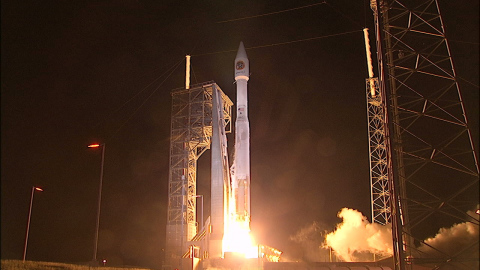Launch Aboard ULA Atlas V Rocket is First of Three Cargo Missions Scheduled for NASA in 2016
S.S. Rick Husband Spacecraft Operating as Planned Early in Mission; Arrival at ISS Scheduled for March 26
DULLES, Va. — (BUSINESS WIRE) — March 22, 2016 — Orbital ATK, Inc. (NYSE: OA), a global leader in aerospace and defense technologies, successfully launched its CygnusTM spacecraft aboard a United Launch Alliance (ULA) Atlas V launch vehicle with approximately 7,900 pounds (3,600 kilograms) of cargo and small satellites that will be deployed directly from the spacecraft. The launch marks the beginning of the company’s fifth operational cargo resupply mission (OA-6) for NASA, and the first Cygnus to conduct scientific experiments onboard the spacecraft. Cygnus will deliver vital equipment, supplies and experiments to astronauts aboard the International Space Station (ISS) as part of its Commercial Resupply Services-1 (CRS-1) contract with NASA.
This Smart News Release features multimedia. View the full release here: http://www.businesswire.com/news/home/20160322006669/en/

Orbital ATK's Cygnus spacecraft was launched aboard United Launch Alliance's Atlas V rocket carrying cargo to the International Space Station for NASA's CRS-1 program. Photo credit: NASA TV
Lift-off of the Atlas V rocket took place at 11:05 p.m. (EDT) on March 22 from Cape Canaveral Air Force Station, Florida. Following a 21-minute ascent, the S.S. Rick Husband Cygnus spacecraft was successfully deployed into its intended orbit approximately 144 miles above the Earth, inclined at 51.6 degrees to the equator. Orbital ATK’s engineering team confirmed that reliable communications have been established and that the vehicle’s solar arrays are fully deployed, providing the necessary electrical power to operate the spacecraft.
“Today’s successful launch continues our great progress and momentum under the CRS contract with NASA,” said Frank Culbertson, President of Orbital ATK’s Space Systems Group. “I applaud the numerous professionals at NASA, ULA and Orbital ATK for their hard work and dedication. While we are still early in this mission, everything is tracking well. We now eagerly await Cygnus’ berthing with the ISS and conducting scientific experiments onboard the spacecraft for the first time.”
Cygnus will be grappled at approximately 6:00 a.m. (EDT) on Saturday, March 26. The spacecraft will remain attached to the ISS for approximately two months before departing with roughly 4,400 pounds (2,000 kilograms) of disposable cargo for a safe, destructive reentry into Earth’s atmosphere over the Pacific Ocean. Cygnus’ large-volume and pressurized disposal cargo capability, a critical service to NASA, is unique among America’s commercial cargo providers.
Under the CRS contract with NASA, Orbital ATK will deliver approximately 59,000 pounds (26,800 kilograms) of cargo to the ISS over 10 missions through 2018. For these missions, NASA will manifest a variety of essential items based on ISS program needs, including food, clothing, crew supplies, spare parts, laboratory equipment and scientific experiments.
The OA-6 mission allows Cygnus to demonstrate its unique flexibility as a spacecraft with capability to launch atop multiple launch vehicles and serve as a platform for science experiments. Once it departs the ISS, Cygnus will enter a specific orbit to deploy five CubeSats, utilizing a NanoRacks CubeSat deployer. Taking place onboard Cygnus, the Spacecraft Fire Experiment-I (Saffire-I) will study the behavior of a large fire in microgravity. The final experiment to take place aboard the S.S. Rick Husband will be the Reentry Breakup Recorder (REBR). The REBR will measure and record Cygnus’ breakup as it reenters Earth’s atmosphere.
The Cygnus system, which consists of a common service module and a pressurized cargo module (PCM), achieves high reliability by incorporating numerous elements from flight-proven spacecraft technologies. The service module is built and tested at Orbital ATK’s Dulles, Virginia manufacturing facility. It uses avionics systems from Orbital ATK’s LEOStar™ and GEOStar™ satellite product lines, plus propulsion and power systems from the company’s GEOStar communications satellites. The recently extended PCM, which is based on the Multi-Purpose Logistics Module developed by Thales Alenia Space for NASA, enables Cygnus to carry over 50 percent more cargo than the previous version. The enhanced Cygnus also uses Orbital ATK’s UltraFlexTM solar arrays, which are the latest in lightweight, space-qualified, electrical power technology. The arrays were manufactured at Orbital ATK’s Goleta, California facility.
Orbital ATK’s composite structures and retro motors also supported today’s launch of the ULA Atlas V rocket. The company manufactured a 10-foot diameter composite heat shield for the launch vehicle, using advanced fiber placement manufacturing techniques at its Luka, Mississippi facility. The Elkton, Maryland facility contributed eight Orbital ATK retro motors, providing thrust for separation of the spent first stage.
Orbital ATK has two additional CRS missions scheduled in 2016 to support
NASA’s ISS cargo and payload mission needs. The company’s upgraded
Antares launch vehicle remains on schedule for a full-power hot-fire
test in late spring. Flight operations for Cygnus and Antares will
resume mid-year from NASA’s Wallops Flight Facility in eastern Virginia.
Beginning in 2019, Orbital ATK will continue its support of the ISS and
its crew by carrying out a minimum of six initial cargo missions under
the recently awarded CRS-2 contract.

